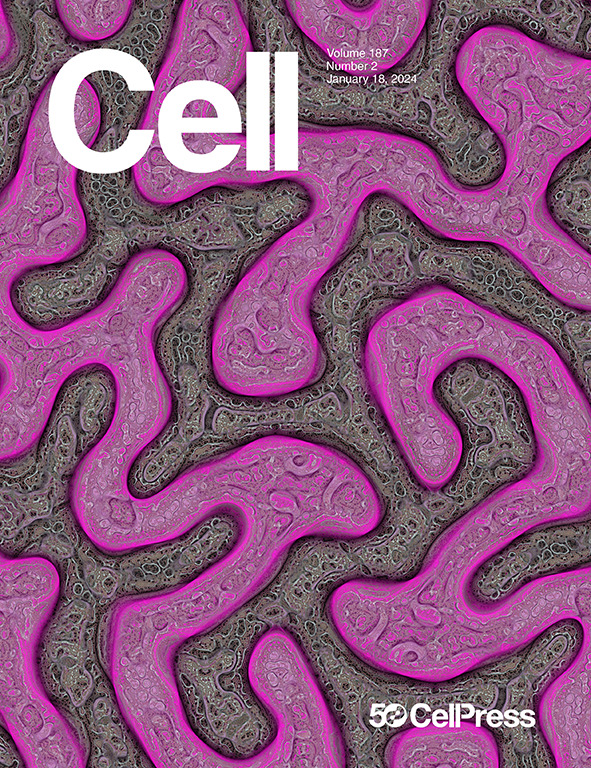脑甲状腺激素通过MCT8和OATP1C1转运的结构研究
IF 42.5
1区 生物学
Q1 BIOCHEMISTRY & MOLECULAR BIOLOGY
引用次数: 0
摘要
充足的甲状腺激素输送到大脑对正常的神经发育至关重要。MCT8和OATP1C1是两种溶质载体(SLC)转运蛋白,介导甲状腺激素穿过血脑屏障进入中枢神经系统。MCT8突变可导致Allan-Herndon-Dudley综合征(AHDS),这是一种以神经发育障碍和周围性甲状腺功能亢进为特征的x系出生缺陷,而OATP1C1缺乏与脑代谢低下和进行性神经退行性变有关。在这里,我们报告了MCT8和OATP1C1分别在2.9和2.3 Å分辨率下与活性甲状腺激素三碘甲状腺原氨酸(T3)和激素原甲状腺素(T4)结合的冷冻电镜(cryo-EM)结构。结合功能研究,我们阐明了它们独特的甲状腺激素识别和转运机制,并解释了疾病突变。虽然细胞外变构位点不是SLC转运体的共同特征,但我们在OATP1C1中发现了一个。总的来说,这些发现阐明了甲状腺激素运输的关键方面,这是发育和疾病的基本过程。本文章由计算机程序翻译,如有差异,请以英文原文为准。

Structural insights into brain thyroid hormone transport via MCT8 and OATP1C1
Adequate delivery of thyroid hormones to the brain is crucial for normal neurological development. MCT8 and OATP1C1, two solute carrier (SLC) transporters, mediate the passage of thyroid hormones across the blood-brain barrier and into the central nervous system. Mutations in MCT8 result in Allan-Herndon-Dudley syndrome (AHDS), an X-linked birth defect characterized by neurodevelopmental impairments and peripheral hyperthyroidism, whereas OATP1C1 deficiency is linked to brain hypometabolism and progressive neurodegeneration. Here, we report cryoelectron microscopy (cryo-EM) structures of MCT8 and OATP1C1 bound with the active thyroid hormone triiodothyronine (T3) and the prohormone thyroxine (T4) at 2.9 and 2.3 Å resolutions, respectively. Combined with functional studies, we elucidate their distinct thyroid hormone recognition and transport mechanisms and explain disease mutations. Although extracellular allosteric sites are not a common feature of SLC transporters, we identify one in OATP1C1. Collectively, these findings illuminate key aspects of thyroid hormone transport, a fundamental process in development and disease.
求助全文
通过发布文献求助,成功后即可免费获取论文全文。
去求助
来源期刊

Cell
生物-生化与分子生物学
CiteScore
110.00
自引率
0.80%
发文量
396
审稿时长
2 months
期刊介绍:
Cells is an international, peer-reviewed, open access journal that focuses on cell biology, molecular biology, and biophysics. It is affiliated with several societies, including the Spanish Society for Biochemistry and Molecular Biology (SEBBM), Nordic Autophagy Society (NAS), Spanish Society of Hematology and Hemotherapy (SEHH), and Society for Regenerative Medicine (Russian Federation) (RPO).
The journal publishes research findings of significant importance in various areas of experimental biology, such as cell biology, molecular biology, neuroscience, immunology, virology, microbiology, cancer, human genetics, systems biology, signaling, and disease mechanisms and therapeutics. The primary criterion for considering papers is whether the results contribute to significant conceptual advances or raise thought-provoking questions and hypotheses related to interesting and important biological inquiries.
In addition to primary research articles presented in four formats, Cells also features review and opinion articles in its "leading edge" section, discussing recent research advancements and topics of interest to its wide readership.
 求助内容:
求助内容: 应助结果提醒方式:
应助结果提醒方式:


